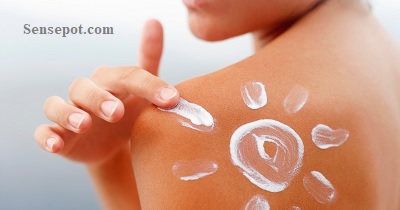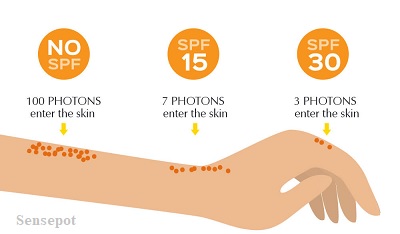With the advent of warm days, we are increasingly trying to get out to parks, to the beaches and, in general, spend more time outdoors, basking in the sun. However, it should be understood that such a strong love for the sun is not mutual. Everyone is well aware of the fact that ultraviolet radiation negatively affects the condition of the skin, but we often do not attach much importance to it, and in vain …

Regardless of the time of the year, sunscreen (sunscreen) should always be in your daily care. Why it is so important, how to choose it, and how to use it correctly – we will talk about all this and more in this article. In the meantime, if you have not yet plunged into the information flow, do not forget to like
How the sun affects the skin
Sunlight hits the Earth’s surface in the form of seven different rays (waves). The most dangerous to humans is ultraviolet (UV) light, namely UVA and UVB rays.
The entire range of ultraviolet radiation accounts for only 5% of UVB rays. They leave your skin not only with a beautiful bronze tan but also often cause sunburn and the appearance of malignant neoplasms.
If we talk about UVA rays, then they take up about 95% of the total amount of ultraviolet emitted by the sun. This type of radiation can penetrate into the deeper layers of the epidermis and cause signs of premature aging.
You may not notice at all how these two types of UV radiation affect the skin for a long time. But this is precisely the insidiousness of love for sunbathing. What happens to the epidermis:
- Collagen and elastin fibers are destroyed;
- Cell DNA is damaged;
- The process of photoaging is activated;
- Freckles and age spots appear ;
- Increases the risk of developing cancer.
That is why dermatologists strongly recommend the daily use of sunscreen cosmetics. Yes, yes, every day, because solar activity persists all year round.
Choosing the Right SPF Level
The first and most important selection criterion is reliable sun protection. It is not so difficult to provide it, you just need to pay attention to some features of this or that sunscreen. And to make it easier for you to decide on a purchase, We have prepared a small cheat sheet.

All about SPF filter
SPF (sun protection factor) means “sun protection factor”. The higher its index, the better the protection against the harmful effects of UV rays. Today on the shelves of stores you can find funds with the following SPF factors:
- SPF 10 – blocks about 90% of UV rays;
- SPF 15 – blocks about 93% of UV rays;
- SPF 30 – blocks about 97% of UV rays;
- SPF 50 – blocks about 98% of UV rays;
- SPF 100 – blocks about 99% of UV rays.
You probably already noticed that the packaging of Korean and Japanese sunscreens has slightly different designations. The level of protection from the sun is marked with the letters “PA”, where:
- PA + – low degree of protection.
- PA ++ – moderate.
- PA +++ – high.
- PA++++ is the highest.
It is better to give preference to products with an SPF factor of at least 30, in the case of Korean and Japanese cosmetics – PA ++.
For aging skin, skin with pigmentation, or during certain cosmetic procedures that increase the photosensitivity of the skin, it is better to give preference to sunscreens with SPF 50+ / PA +++.
Also, before purchasing these products, pay attention to the fact that they have a wide spectrum of protection (the ability to withstand the effects of UVA and UVB rays).
Chemical or natural?
Conventionally, all sunscreens can be divided into two types: chemical and natural (mineral). That’s just not necessary to immediately reject the first option because of the name. Both tools have proven themselves equally well, but each has its characteristics. Let’s consider each of them.
- Chemical filter. It is absorbed into the upper layer of the skin and works on the principle of absorbing ultraviolet rays. A key feature is a light texture, so sunscreens with chemical filters are mainly intended for the face. It is necessary to apply the product about half an hour before going outside, as it must have time to be absorbed into the skin.
- Natural (mineral) filter. Remains on the surface of the epidermis, creating a protective barrier and reflecting UV rays. The disadvantages include a white film that remains on the skin after applying the product.
With this point sorted out, we can move on.
How to Choose the Right Sunscreen for Your Needs
Do you remember when you could buy sunscreen only in the form of a cream …? Today, manufacturers allow to choose the most suitable format for themselves:

- Cream;
- Oil;
- Lotion;
- Fluid;
- Milk;
- Spray;
- Stick;
- Powder.
For even greater convenience, SPF filters have appeared in the composition of care and decorative cosmetics. Now you do not need to buy two products separately. It’s convenient!
Don’t Forget Your Skin Type
This is perhaps one of the most important selection criteria because, in addition to reliable protection from solar activity, you must also take into account the needs of the skin.
You can also get How to Keep Fresh Makeup in the Heat? 10 Useful Tips
Oily and problematic skin. In this case, creamy thick products will not work, on the contrary, preference should be given to light textures with a matting effect.
Dry and sensitive skin. This type of epidermis requires a special approach to the choice of sunscreen. First of all, you need to worry about additional hydration and soothing. Therefore, your choice is hypoallergenic formulations and preferably without fragrances.
Combination skin. The peculiarity of combination skin is that it combines both dry areas of the epidermis and the T-zone with the active synthesis of sebum. It is necessary to select a product with a moisturizing effect but at the same time with a loose texture. To moisturize drier areas of the skin, you can first apply a day cream.
Normal skin. For people with this type of epidermis, any sunscreen is suitable. Therefore, you just have to choose a convenient format (cream, spray, milk, etc.)
How often do you need to update the sunscreen during the day?
To make your sun exposure as safe as possible, you need to reapply sunscreen cosmetics to the surface of the skin every two hours. Why is that? The effectiveness of these cosmetic products is gradually decreasing, this is because the epidermis actively releases sebum and sweat, washing away the same protective layer. And if you decide to visit the beach or the pool, then in this case the sunscreen will be washed off the skin even faster. Therefore, it is so important not to forget to regularly update the protective layer.
What is the difference between face and body sunscreen?
In fact, there is no difference, except perhaps only in the size of the package. For daily use in the cooler season, of course, it is better to purchase a separate facial sunscreen, tailored to the needs of your epidermis. In the summer, when there are more open areas of the body, you need to take a more serious approach to the issue of protecting the epidermis from UV rays by buying a universal remedy or a separate one for the face and body.
And finally, I would like to once again emphasize that sunscreen cosmetics is an indispensable product in your daily care. Love your skin, and take care of it properly so that it shines with youth, beauty, and health!


